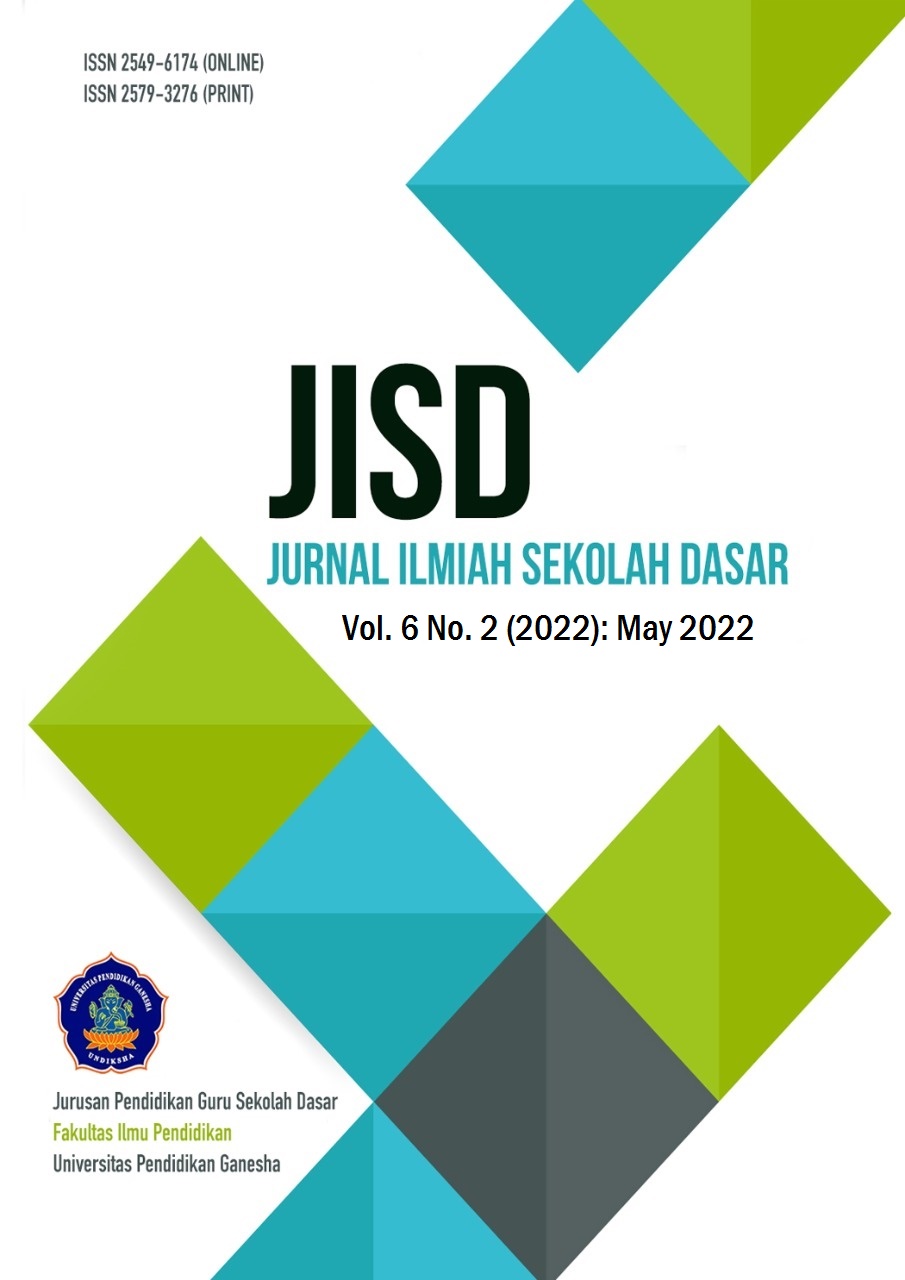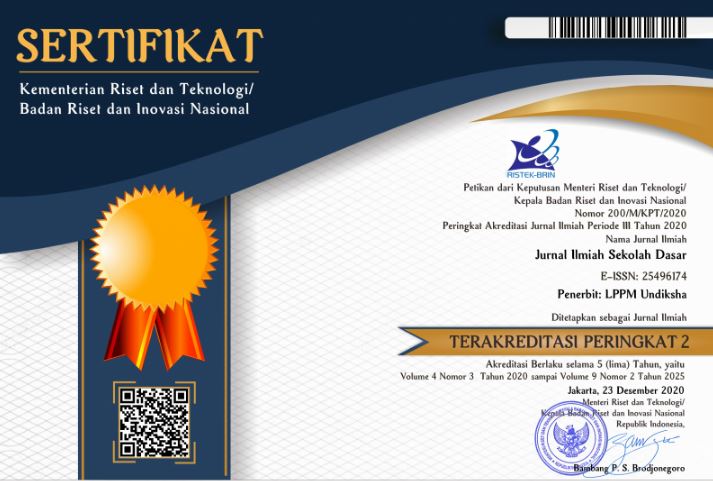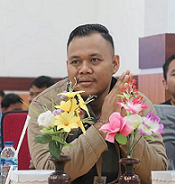Teacher Efficacy and Teacher Social Perception in Creative Teaching for Elementary School Teachers
DOI:
https://doi.org/10.23887/jisd.v6i2.44760Keywords:
Creative Teaching, Teacher Efficacy, Social PerceptionAbstract
Creativity is a competency that teachers need to have, especially in the learning process, to support the formation of creative thinking processes in children. Creative teaching needs to be applied especially in the learning of elementary school children because they are in a critical period in forming creative thinking processes. Teachers play a role in fostering and increasing creativity in children in elementary school. This study analyzes the correlation between teacher efficacy and teacher perceptions of creativity on creative teaching behavior during school learning. This study uses a quantitative approach. A sampling of data on 43 elementary school teachers from several cities in Indonesia was conducted using a simple random technique. The measuring tools used in this research are the Creativity Fostering Teacher Index (CFTI) and the Teaching for Creativity Scale (TFCS). The data obtained were tested quantitatively using simple linear regression analysis. The results showed that self-efficacy and teacher perceptions influence creativity and creative teaching behavior. Increased teacher efficacy has been proven to help teachers to form self-confidence in creative teaching. On the other hand, the teacher's perception of creativity will also affect teacher efficacy in applying creativity to the teaching and learning process.
References
Adnan, F., Prasetyo, B., & Nuriman, N. (2017). Usability testing analysis on the Bana game as education game design references on junior high school. Jurnal Pendidikan IPA Indonesia, 6(1), 88–94. https://doi.org/10.15294/jpii.v6i1.9597. DOI: https://doi.org/10.15294/jpii.v6i1.9597
Alvarez-Huerta, P., Muela, A., & Larrea, I. (2022). Disposition toward critical thinking and creative confidence beliefs in higher education students: The mediating role of openness to diversity and challenge. Thinking Skills and Creativity, 43(December 2021). https://doi.org/10.1016/j.tsc.2022.101003. DOI: https://doi.org/10.1016/j.tsc.2022.101003
Andriani, T. (2012). Permainan tradisional dalam membentuk karakter anak usia dini. Sosial Budaya, 9(1), 121–136. https://doi.org/10.24014/sb.v9i1.376.
Antara, P. A. (2018). Stimulasi Metode Permainan Kreatif Berdesain Creative Movement Dan Budi Pekerti Dalam Mengembangkan Kemampuan Spasial Anak. JPUD - Jurnal Pendidikan Usia Dini, 12(2), 301–310. https://doi.org/10.21009/jpud.122.11. DOI: https://doi.org/10.21009/JPUD.122.11
Ata-Akturk, A., & Sevimli-Celik, S. (2020). Creativity in early childhood teacher education: beliefs and practices. International Journal of Early Years Education, 1–20. https://doi.org/10.1080/09669760.2020.1754174. DOI: https://doi.org/10.1080/09669760.2020.1754174
Baghetto, R. (2010). Creativity in the classroom. Cambridge University Press. DOI: https://doi.org/10.1017/CBO9780511763205.027
Basadur, M., Graen, G. B., & Green, S. G. (1982). Training in creative problem solving: Effects on ideation and problem finding and solving in an industrial research organization. Organizational Behavior and Human Performance, 30(1), 41–70. https://doi.org/10.1016/0030-5073(82)90233-1. DOI: https://doi.org/10.1016/0030-5073(82)90233-1
Budi. (2000). Ipi Pengaruh Efikasi Diri Terhadap Minat Berwirausaha Pada Siswa Kelas Xii Di Smk Negeri 1 Surabaya. Jurnal Pendidikan Tata Niaga (JPTN), 1(1), 1–2. https://ejournal.unesa.ac.id/index.php/jptn/article/view/1902.
Chen, H. H., & Yuan, Y. H. (2021). The Study of the Relationships of Teacher’s Creative Teaching, Imagination, and Principal’s Visionary Leadership. SAGE Open, 11(3). https://doi.org/10.1177/21582440211029932. DOI: https://doi.org/10.1177/21582440211029932
Chesnut, S. R., & Burley, H. (2015). Self-Efficacy as a Predictor of Commitment to the Teaching Profession: A Meta-Analysis. Educational Research Review, 15, 1–50. https://doi.org/10.1016/j.edurev.2015.02.001. DOI: https://doi.org/10.1016/j.edurev.2015.02.001
Delen, E., & Kaya, F. (2013). Creativity in the primary classroom. European Journal of Teacher Education, 36(2), 233–235. https://doi.org/10.1080/02619768.2012.762506. DOI: https://doi.org/10.1080/02619768.2012.762506
Dere, Z. (2019). Investigating the creativity of children in early childhood education institutions. Universal Journal of Educational Research, 7(3), 652–658. https://doi.org/10.13189/ujer.2019.070302. DOI: https://doi.org/10.13189/ujer.2019.070302
Dewi, F. (2015). Proyek buku digital: Upaya peningkatan keterampilan abad 21 calon guru sekolah dasar melalui model pembelajaran berbasis proyek. Metodik Didaktik: Jurnal Pendidikan Ke-SD-An, 9(2). https://doi.org/10.17509/md.v9i2.3248.
Dow, G. T., & Mayer, R. E. (2004). Teaching students to solve insight problems: Evidence for domain specificity in creativity training. Creativity Research Journal, 16(4), 389–398. https://doi.org/10.1080/10400410409534550. DOI: https://doi.org/10.1080/10400410409534550
Esquivel, G. B. (1995). Teacher behaviors that foster creativity. Educational Psychology Review, 7(2), 185–202. https://doi.org/10.1007/BF02212493. DOI: https://doi.org/10.1007/BF02212493
Evriani, T., & Kumalasari, D. (2019). The Role of Teachers’ Attitudes Toward Teacher’s Efficacy in Education Inclusion in Jakarta Public Elementary School. Indonesian Journal Of Learning Education and Counseling, 2(1), 62 – 69. https://doi.org/10.31960/ijolec.v2i1.177. DOI: https://doi.org/10.31960/ijolec.v2i1.177
Fitriana, S., Ihsan, H., & Annas, S. (2015). Pengaruh efikasi diri, aktivitas, kemandirian belajar dan kemampuan berpikir logis terhadap hasil belajar matematika pada siswa kelas VIII SMP. Journal of Educational Science and Technology (EST), 1(2), 86–101. https://doi.org/10.26858/est.v1i2.1517. DOI: https://doi.org/10.26858/est.v1i2.1517
Florida, R., Mellander, C., & King, K. (2015). The global creativity index 2015. Martin Prosperity Institute.
Grainger, T., Barnes, J., & Scoffham, S. (2004). A creative cocktail: Creative teaching in initial teacher education. Journal of Education for Teaching, 30(3), 243–253. https://doi.org/10.1080/0260747042000309475. DOI: https://doi.org/10.1080/0260747042000309475
Hadisi, L., Astina, W. O., & Wampika, W. (2017). Pengaruh Kreativitas Mengajar Guru Terhadap daya Serap Siswa Di SMK Negeri 3 Kendari. Al-TA’DIB: Jurnal Kajian Ilmu Kependidikan, 10(2). https://doi.org/10.31332/atdb.v10i2.629.
Hartley, K. A., Plucker, J. A., & Long, H. (2016). Creative self-efficacy and teacher ratings of student creativity in Chinese elementary classrooms. Thinking Skills and Creativity, 22, 142–151. https://doi.org/10.1016/j.tsc.2016.10.001. DOI: https://doi.org/10.1016/j.tsc.2016.10.001
Holzberger, D., & Prestele, E. (2021). Teacher self-efficacy and self-reported cognitive activation and classroom management: A multilevel perspective on the role of school characteristics. Learning and Instruction, 76, 101513. https://doi.org/10.1016/j.learninstruc.2021.101513. DOI: https://doi.org/10.1016/j.learninstruc.2021.101513
Huang, X. (2022). Constructing the associations between creative role identity, creative self-efficacy, and teaching for creativity for primary and secondary teachers. Psychology of Aesthetics, Creativity, and the Arts. https://doi.org/10.1037/aca0000453. DOI: https://doi.org/10.1037/aca0000453
Huang, Xianhan, Lee, J. C.-K., & Dong, X. (2019). Mapping the factors influencing creative teaching in mainland China: An exploratory study. Thinking Skills and Creativity, 31, 79–90. https://doi.org/10.1016/j.tsc.2018.11.002. DOI: https://doi.org/10.1016/j.tsc.2018.11.002
Kampylis, P., Berki, E., & Saariluoma, P. (2009). In-service and prospective teachers’ conceptions of creativity. Thinking Skills and Creativity, 4(1), 15–29. https://doi.org/10.1016/j.tsc.2008.10.001. DOI: https://doi.org/10.1016/j.tsc.2008.10.001
Kim, K. H. (2011). The APA 2009 Division 10 debate: Are the Torrance Tests of Creative Thinking still relevant in the 21st century. Psychology of Aesthetics, Creativity, and the Arts, 5(4), 302. https://doi.org/10.1037/a0021917. DOI: https://doi.org/10.1037/a0021917
Kuswariningsih, S. (2016). Korelasi Kebiasaan Belajar, Kreatifitas Belajar dan Prestasi Belajar IPS. Jurnal Penelitian Dan Pendidikan IPS, 10(3), 389–395. http://ejournal.unikama.ac.id/index.php/JPPI.
Lee, I. R., & Kemple, K. (2014). Preservice teachers’ personality traits and engagement in creative activities as predictors of their support for children’s creativity. Creativity Research Journal, 26(1), 82–94. https://doi.org/10.1080/10400419.2014.873668. DOI: https://doi.org/10.1080/10400419.2014.873668
Leggett, N. (2017). Early childhood creativity: Challenging educators in their role to intentionally develop creative thinking in children. Early Childhood Education Journal, 45(6), 845–853. https://doi.org/10.1007/s10643-016-0836-4. DOI: https://doi.org/10.1007/s10643-016-0836-4
Lestariani, L. P., Mahadewi, L. P. P., & Antara, P. A. (2019). Pengaruh Model Pembelajaran Tari Kreatif terhadap Kemampuan Motorik Kasar Kelompok B Gugus I Kecamatan Banjar. Jurnal Pendidikan Anak Usia Dini Undiksha, 7(3), 236–245. https://doi.org/10.23887/paud.v7i2.19010. DOI: https://doi.org/10.23887/paud.v7i2.19010
McVey, M. (2016). Preservice Teachers’ Perception of Assessment Strategies in Online Teaching. Journal of Digital Learning in Teacher Education, 32(4), 119–127. https://doi.org/10.1080/21532974.2016.1205460. DOI: https://doi.org/10.1080/21532974.2016.1205460
Monika, M., & Adman, A. (2017). Peran Efikasi Diri Dan Motivasi Belajar Dalam Meningkatkan Hasil Belajar Siswa Sekolah Menengah Kejuruan. Jurnal Pendidikan Manajemen Perkantoran, 2(2), 219–226. https://doi.org/10.17509/jpm.v2i2.8111. DOI: https://doi.org/10.17509/jpm.v2i2.8111
Morin, S. (2022). Systematic Literature Review: Self-Eficacy Matematis Siswa pada Tipe Kepribadian Extrovert dan Introvert dalam Pembelajaran Matematika. ANARGYA: Jurnal Ilmiah Pendidikan Matematika, 5(1). https://doi.org/10.24176/anargya.v5i1.7192. DOI: https://doi.org/10.24176/anargya.v5i1.7192
Mulyani, N. (2019). Pengembangan Kreativitas Anak Usia Dini Melalui Bermain Gerak Dan Lagu Di TK Negeri Pembina Kabupaten Purbalingga. As-Sibyan : Jurnal Pendidikan Anak Usia Dini, 4(1), 13–24. https://doi.org/10.32678/as-sibyan.v4i1.1961. DOI: https://doi.org/10.32678/as-sibyan.v4i1.1961
Octaberlina, L. R., & Muslimin, A. I. (2020). Efl Students Perspective Towards Online Learning Barriers And Alternatives Using Moodle/Google Classroom During Covid-19 Pandemic. International Journal of Higher Education, 9(6), 1–9. https://doi.org/10.5430/ijhe.v9n6p1. DOI: https://doi.org/10.5430/ijhe.v9n6p1
Pentury, H. J. (2017). Pengembangan kreativitas guru dalam pembelajaran kreatif pelajaran Bahasa Inggris. Faktor: Jurnal Ilmiah Kependidikan, 4(3), 265–272. https://doi.org/10.30998/fjik.v4i3.1923.
Prihastyanti, I., & Sawitri, D. R. (2020). Dukungan guru dan efikasi diri akademik pada siswa SMA Semesta Semarang. Jurnal Empati, 7(3), 867–880. https://doi.org/10.14710/empati.2018.21740. DOI: https://doi.org/10.14710/empati.2018.21740
Putri, D. A. W. M., & Widyana, R. (2021). Peran persepsi keterlibatan orangtua dan peran sosial guru dengan efikasi diri akademis siswa dalam pembelajaran online di masa pandemi. Jurnal Konseling Dan Pendidikan, 9(2), 139–146. https://doi.org/10.29210/155500. DOI: https://doi.org/10.29210/155500
Rezieka, D. G., Wibowo, D. V., & Fatmawati, F. (2021). Rejuvinasi Strategi Pengembangan Kreativitas Anak di PAUD. Al-Athfaal: Jurnal Ilmiah Pendidikan Anak Usia Dini, 4(1), 31–46. https://doi.org/10.24042/ajipaud.v4i1.8186. DOI: https://doi.org/10.24042/ajipaud.v4i1.8186
Roebianto, A. (2020). The Effects of Student’s Attitudes and Self-Efficacy on Science Achievement. Jurnal Pengukuran Psikologi Dan Pendidikan Indonesia (JP3I), 9(1), 1–10. https://doi.org/10.15408/jp3i.v9i1.14490. DOI: https://doi.org/10.15408/jp3i.v9i1.14490
Roustae, R., Pourrajab, M., Kasmaienezhadfard, S., & Talebloo, B. (2015). Students’ Learning Through Teaching Creativity: Teachers’ Perception. Journal of Educational, Health and Community Psychology, 4(1), 1–13.
Rubenstein, L. D., McCoach, D. B., & Siegle, D. (2013). Teaching for creativity scales: An instrument to examine teachers’ perceptions of factors that allow for the teaching of creativity. Creativity Research Journal, 25(3), 324–334. https://doi.org/10.1080/10400419.2013.813807. DOI: https://doi.org/10.1080/10400419.2013.813807
Saputra, R. M. A., Hariyadi, A., & Sarjono, S. (2021). Pengaruh Motivasi Dan Efikasi Diri Terhadap Kemandirian Belajar Sistem Daring Pada Siswa Kelas XII IPS SMA Negeri Kedungadem Bojonegoro. Jurnal Educatio FKIP UNMA, 7(3), 840–847. https://doi.org/10.31949/educatio.v7i3.1268. DOI: https://doi.org/10.31949/educatio.v7i3.1268
Satria, A. V., & Kristiono, M. J. (2018). Pengaruh Persepsi Konstruksi Sosial Kawasan Asia Timur Terhadap Kebijakan Nuklir Korea Utara : Analisis Terhadap Perubahan Sikap Korea Utara Menuju Deklarasi Panmunjom. Insignia: Journal of International Relations, 5(2), 109–126. https://doi.org/10.20884/1.ins.2018.5.2.1300.
Setiawan, D. (2014). Pendidikan Kewarganegaraan Berbasis Karakter melalui Penerapan Pendekatan Pembelajaran Aktif, Kreatif, Efektif dan Menyenangkan. JUPIIS: Jurnal Pendidikan Ilmu-Ilmu Sosial, 6(2), 61–72. https://doi.org/10.24114/jupiis.v6i2.2285. DOI: https://doi.org/10.24114/jupiis.v6i2.2285
Setyaningtyas, E. W. (2019). Potensi metode 1: 4: P: C: R untuk mengembangkan keterampilan berpikir kritis dan kreatif. Scholaria: Jurnal Pendidikan Dan Kebudayaan, 9(2), 111–121. https://doi.org/10.24246/j.js.2019.v9.i2.p111-121. DOI: https://doi.org/10.24246/j.js.2019.v9.i2.p111-121
Sharma, E., & Sharma, S. (2018). Creativity nurturing behaviour scale for teachers. International Journal of Educational Management, 32(6), 1016–1028. https://doi.org/10.1108/IJEM-10-2017-0294. DOI: https://doi.org/10.1108/IJEM-10-2017-0294
Siron, Y. (2020). PAUD Inklusif: Efikasi Diri dan Tingkat Literasi Guru Memengaruhi Kemampuan Merancang Individualized Education Program (IEP)? Al-Athfal : Jurnal Pendidikan Anak, 6(1), 1 – 14. https://doi.org/10.14421/al-athfal.2020.61-01. DOI: https://doi.org/10.14421/al-athfal.2020.61-01
Skaalvik, E. M., & Skaalvik, S. (2010). Teacher self-efficacy and teacher burnout: A study of relations. Teaching and Teacher Education, 26(4), 1059–1069. https://doi.org/10.1016/j.tate.2009.11.001. DOI: https://doi.org/10.1016/j.tate.2009.11.001
Soh, K. C. (2000). Indexing creativity fostering teacher behavior: A preliminary validation study. The Journal of Creative Behavior, 34(2), 118–134. https://doi.org/10.1002/j.2162-6057.2000.tb01205.x. DOI: https://doi.org/10.1002/j.2162-6057.2000.tb01205.x
Suryani, L., Pendi, A., & B. Seto, S. (2020). Pengaruh Efikasi Diri Dan Kemandirian Belajar Terhadap Hasil Belajar Mata Kuliah Geometri Dasar Pada Mahasiswa Program Studi Pendidikan Matematika Universitas Flores. AKSIOMA : Jurnal Matematika Dan Pendidikan Matematika, 11(1), 17–26. https://doi.org/10.26877/aks.v11i1.6010. DOI: https://doi.org/10.26877/aks.v11i1.6010
Syamsuar, S., & Reflianto, R. (2019). Pendidikan dan tantangan pembelajaran berbasis teknologi informasi di era revolusi industri 4.0. E-Tech: Jurnal Ilmiah Teknologi Pendidikan, 6(2). https://doi.org/10.24036/et.v2i2.101343. DOI: https://doi.org/10.24036/et.v2i2.101343
Widarti, H. R., Rokhim, D. A., & Syafruddin, A. B. (2020). The Development Of Electrolysis Cell Teaching Material Based On Stem-Pjbl Approach Assisted By Learning Video: A Need Analysis. Jurnal Pendidikan IPA Indonesia, 9(3), 309–318. https://doi.org/10.15294/jpii.v9i3.25199.
Wulandari, D., & Sari, N. I. (2019). Pengaruh Efikasi Diri dan Kemandirian Belajar terhadap Prestasi Belajar Matematika Siswa Kelas X Akutansi di SMK Paskita Global Jakarta. Diskusi Panel Nasional Pendidikan Matematika 2019, 5(3), 435–446. http://proceeding.unindra.ac.id/index.php/DPNPMunindra/article/view/612.
Downloads
Published
How to Cite
Issue
Section
License
Copyright (c) 2022 Yaumil Fadhilah, Rose Mini Agoes Salim, Shahnaz Safitri

This work is licensed under a Creative Commons Attribution-ShareAlike 4.0 International License.
Authors who publish with the Journal Ilmiah Sekolah Dasar agree to the following terms:
- Authors retain copyright and grant the journal the right of first publication with the work simultaneously licensed under a Creative Commons Attribution License (CC BY-SA 4.0) that allows others to share the work with an acknowledgment of the work's authorship and initial publication in this journal.
- Authors are able to enter into separate, additional contractual arrangements for the non-exclusive distribution of the journal's published version of the work (e.g., post it to an institutional repository or publish it in a book), with an acknowledgment of its initial publication in this journal.
- Authors are permitted and encouraged to post their work online (e.g., in institutional repositories or on their website) prior to and during the submission process, as it can lead to productive exchanges, as well as earlier and greater citation of published work. (See The Effect of Open Access)











